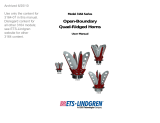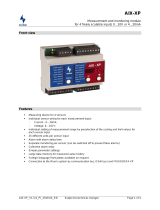
Configurable Node with 2 discrete inputs, 2 discrete outputs, 2 analog inputs, and 2 analog outputs
The SureCross® wireless system is a radio frequency network with integrated I/O that can oper-
ate in most environments and eliminate the need for wiring runs. Wireless networks are formed
around a Gateway, which acts as the wireless network master device, and one or more Nodes.
• Wireless industrial I/O device with two selectable discrete inputs, two sourcing discrete out-
puts, two 0 to 20 mA analog inputs, and two 0 to 20 mA analog outputs
• 10 to 30V dc power input
• DIP switches for user configuration
• Frequency Hopping Spread Spectrum (FHSS) technology and Time Division Multiple Access
(TDMA) control architecture ensure reliable data delivery within the unlicensed Industrial, Sci-
entific, and Medical (ISM) band
• Transceivers provide bidirectional communication between the Gateway and Node, including
fully acknowledged data transmission
• Lost RF links are detected and relevant outputs set to user-defined conditions
For additional information, updated documentation, and accessories, refer to Banner Engineering's website, www.bannerengineer-
ing.com/surecross.
Models Frequency Antenna I/O
DX80N9X6S2P2M2M2
900 MHz ISM Band
External
Inputs: Two selectable discrete, two 0 to 20 mA analog
Outputs: Two sourcing discrete, two 0 to 20 mA analog
DX80N9X6W2P2M2M2 Internal
WARNING: Not To Be Used for Personnel Protection
Never use this device as a sensing device for personnel protection. Doing so could lead to serious
injury or death. This device does not include the self-checking redundant circuitry necessary to allow its
use in personnel safety applications. A sensor failure or malfunction can cause either an energized or de-
energized sensor output condition.
SureCross User Configuration Tool
The User Configuration Tool (UCT) offers an easy way to link I/O points in your wire-
less network, view I/O register values graphically, and set system communication pa-
rameters when a host system is not part of the wireless network.
The UCT requires a special USB to RS-485 (model number BWA-UCT-900 for 1 Watt
radios, BWA-HW-006 can be used for all other radios) converter cable to pass infor-
mation between your computer and the Gateway. Download the most recent revi-
sions of the UCT software from Banner Engineering's website: http://www.banneren-
gineering.com/wireless.
Setting Up Your Wireless Network
To set up and install your wireless network, follow these steps:
1. Configure the DIP switches of all devices.
2. Connect the sensors to the SureCross devices.
3. Apply power to all devices.
4. Form the wireless network by binding the Nodes to the Gateway. If the binding instructions are not included in the datasheet, refer to
the product manual for binding instructions.
5. Observe the LED behavior to verify the devices are communicating with each other.
6. Conduct a site survey between the Gateway and Nodes. If the site survey instructions are not included in this datasheet, refer to the
product manual for detailed site survey instructions.
SureCross DX80 Node
P/N 131295 Rev. F 5/21/2013









